Spain, with its rich history and deep-rooted religious traditions, has an impressive collection of churches spanning different architectural styles and historical periods. Spain’s churches are a living testimony of the country’s diverse cultural heritage and unwavering devotion to spirituality. In this article, we will embark on a journey through some of Spain’s most fascinating churches, each a masterpiece in its own right.
Sagrada Familia Church (Basilica and Expiatory Church of the Holy Family)
The basilica known as the Sagrada Familia is one of the most iconic churches in Spain and one of the most breathtaking sights in the world, located in the city of Barcelona, Spain. This historic church is a testament to the genius of its architect, Antoni Gaudi, and the enduring dedication of the countless workers and artisans who contributed to its construction over the years.
Sagrada Familia is one of the most visited tourist attractions in Spain, attracting millions of visitors from all over the world every year. It is also registered as a UNESCO World Heritage Site. While the church is a major tourist attraction, it is still active as a place of worship. It hosts religious ceremonies and is an important pilgrimage site for Catholics and Christians around the world. Let’s explore the significance and features of this remarkable church.
The unique features of Sagrada Familia church
- Facade sculpturesSagrada Familia has three main facades: Jesus Christ, Passion and Glory. Each view is a masterpiece in itself that depicts different aspects of the Christian faith. Designed by Gaudi himself, the Facade of Jesus Christ is particularly famous for its intricate, Jesus-themed sculptures.
- Interior space: The interior of the basilica is a stunning space with soaring columns designed to mimic the appearance of a dense forest. The columns branch out like tree limbs and create a sense of awe and reverence. Colorful stained glass windows fill the interior with a mesmerizing interplay of light and color.
- Symbolism: Gaudi incorporated deep religious symbolism into every aspect of Sagrada Familia’s design. The interior, in particular, is filled with religious motifs and biblical stories told through sculptures and artwork.
- The towers: The church has a total of 18 towers, each of which has its own unique design and symbol. The central tower, representing Jesus Christ, will be the tallest, surrounded by towers representing the twelve apostles, the Virgin Mary, and the four evangelists.
Read more: Introduction of Spanish festivals
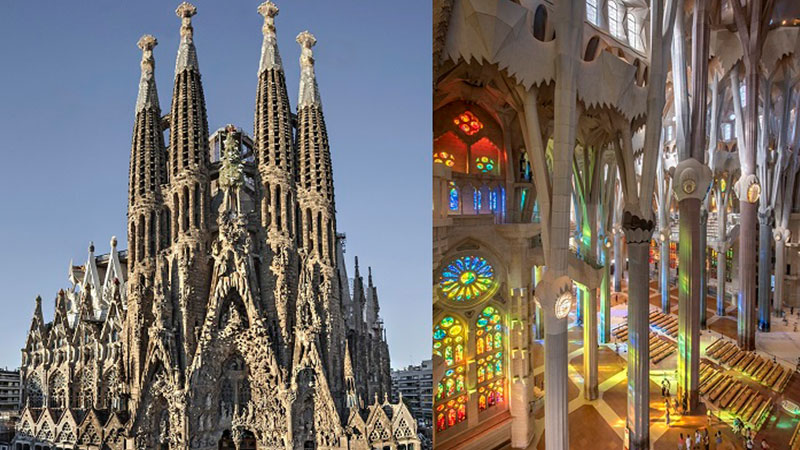
Seville Cathedral (Seville Cathedral) is one of the Spanish churches
The Cathedral of Saint Mary of the See, known as the Cathedral of Seville, is a historic and magnificent church located in Seville, Spain. This church is one of the largest and most impressive Gothic churches in the world and has a special place in the history and architecture of Spain among Spanish churches. Here, we will explore the importance, history and key features of this church.
The unique features of St. Mary C
- Construction: The construction of the church began in the early 15th century and continued for several centuries, resulting in a masterpiece that blends different architectural styles.
- UNESCO World Heritage Site: The Cathedral of Seville, together with the adjacent Alcázar and Arco de Indias, is collectively recognized as a UNESCO World Heritage Site, highlighting its cultural and historical importance among Spanish churches.
- Gothic and Renaissance styles: The architectural style of the church is mainly Gothic, but it also contains elements of the Renaissance and Modjar styles. Its massive size and intricate design make it an outstanding example of Spanish Gothic architecture.
- Bell Tower (Giralda): Seville’s most iconic church feature is the Giralda, a former minaret converted into a bell tower. Instead of stairs, the Giralda is famous for its unique ramp that allows people to climb up on horseback. A view from the top offers stunning panoramic views of Seville.
- Nave and altar: The interior of the church is equally impressive, featuring a vast nave with tall Gothic arches and beautiful stained glass windows. The main altar has a magnificent work of art created by various artists including Pedro de Campana and Pierre Dankart.
- Churches: The church consists of several churches, each with unique artworks, sculptures and religious significance. One of the most famous is the Church of the Virgin of the Kings, where Christopher Columbus is believed to be buried. The cathedral is the final resting place of several Spanish kings, including Ferdinand III and Alfonso X.
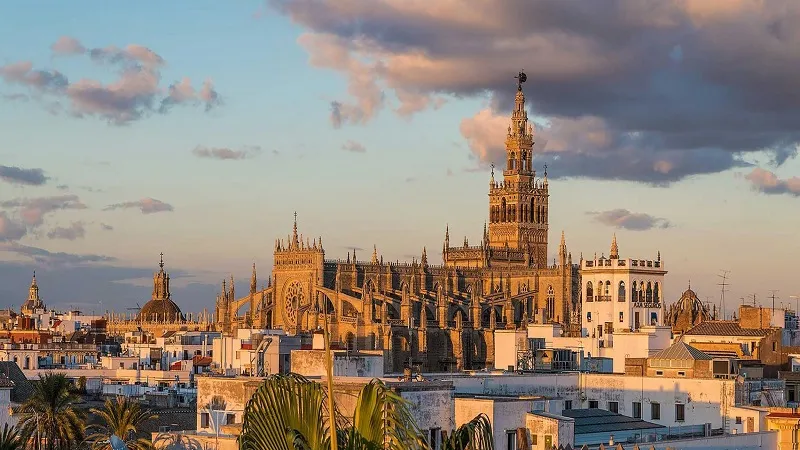
Alhambra Church
El Alhambra, a UNESCO World Heritage Site located in Granada, Spain, is a stunning palace and castle complex that showcases the rich history of Moorish architecture and Islamic culture. This church is one of Spain’s most iconic churches and is one of the best examples of Islamic architecture in the world, famous for its intricate details, breathtaking gardens, and historical significance. Here, we will look at the architecture, cultural significance and unique features of El Alhambra.
The unique features of El Alhambra Church
- the palaces: This complex consists of several palaces, each of which has its own unique character and design. The Nasserite palaces, including Maksoor, Kumars Palace and the Court of Lions, are famous for their exquisite beauty and intricate tiling.
- the gardens: El Alhambra is famous for its stunning gardens, including the Generalife Gardens, which feature greenery, fountains, reflecting pools and a design that showcases the Islamic concept of paradise.
- Nasrid fortifications: El Alhambra also served as a fortress with impressive walls and towers like the Alcazaba, offering strategic views of Granada.
Read more: Introducing the most amazing beaches in Spain
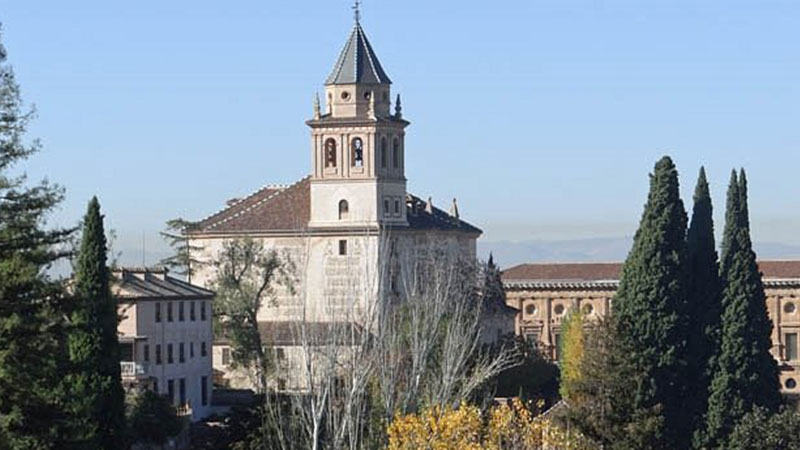
Toledo Cathedral is one of the most famous churches in Spain
Toledo Cathedral, also known as Santa Maria de Toledo, is a magnificent Gothic cathedral located in the historic city of Toledo, Spain. This stunning church is not only a prominent religious site, but also a remarkable cultural and architectural landmark among Spanish churches. Let’s explore the history, architecture and cultural significance of the Toledo Cathedral.
Unique features of Toledo Cathedral
- Gothic architecture: Toledo Cathedral is a prime example of Spanish Gothic architecture, characterized by pointed arches, ribbed vaults, and intricate ornamentation. It has a three-bay church plan with a series of chapels and side chapels.
- facade and doors: The exterior is decorated with elaborate sculptures, including scenes from the Bible and various religious figures.
- high altar: The high altar of the church is a masterpiece of baroque art. It has a magnificent combination of sculpture, painting and gilded stucco that creates a stunning visual effect.
- Churches: Church Toledo is home to several churches, each with unique artwork and history. The Chapel of the New Kings, the Mozarabi Chapel and the Church of the Kings are among the most prominent.
- Art and decoration: The interior is decorated with an impressive collection of religious art, including paintings, sculptures, and decorative elements, representing the works of prominent artists throughout the centuries.
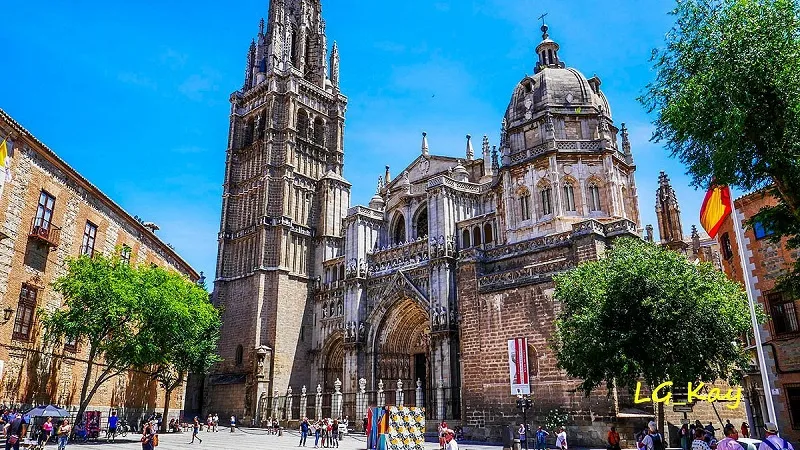
Santiago de Compostela Cathedral
The Church of Santiago de Compostela, also known as the Church of St. James, is a historic and important Catholic church located in Santiago de Compostela, in the Galicia region of northwestern Spain. This church is one of the most important churches in Spain and pilgrimage destinations in the Christian world and has a deep religious and cultural significance. Let’s explore the unique features of this church.
Unique features of Santiago de Compostela Cathedral
- Roman and Baroque styles: The architectural style of the church is primarily Roman and has some Baroque and Gothic elements. Its intricate facades, ornate sculptures and stunning interiors reflect the artistic sensibilities of different historical periods.
- Porch of glory: One of the most famous features of the church is the Porta de la Gloria, a masterpiece of Roman sculpture. It features intricate carvings and sculptures, including an image of St. James at its center.
- Botafumiro: This church is famous for its censer or botafumiro. During special occasions and religious celebrations, the botafumiro is passed through the nave by a group of tiraboliro on a rope, filling the church with fragrant incense.
- Churches and altars: The interior of the church is decorated with numerous chapels, each of which has unique works of art and religious significance. The high altar is a masterpiece of baroque art.
Read more: attractions of Seville, Spain
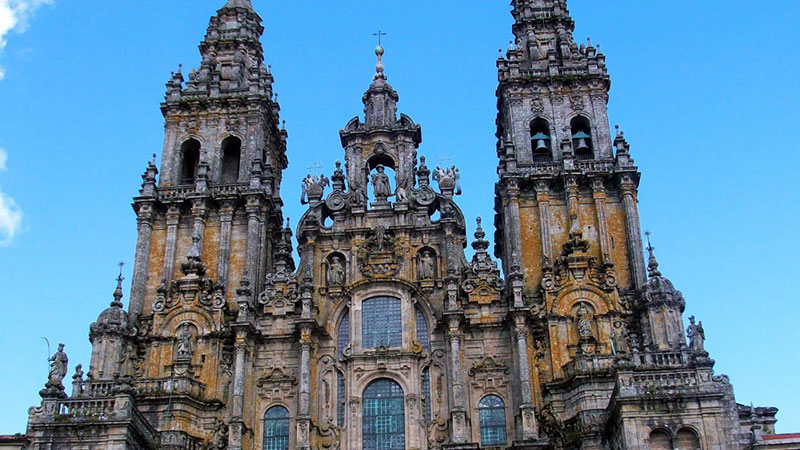
Santa Maria del Mar Church is one of the most special churches in Spain
Santa María del Mar is a magnificent Gothic cathedral located in the heart of Barcelona, Catalonia, Spain. This church is famous among Spanish churches for its stunning architecture and rich historical and cultural significance. Let’s dive into the unique features of Santa Maria del Mar.
The unique features of the Church of Santa Maria del Mar
- Gothic architecture: Santa Maria del Mar is an outstanding example of Catalan Gothic architecture, which is characterized by simplicity, harmony and elegance. The design of the church emphasizes spaciousness, with wide aisles and soaring columns.
- rose window: The large rose window on the west facade is a striking feature that allows a beautiful play of light to illuminate the interior. This window is decorated with paintings and colored glass.
- Ribbed columns and arches: The interior of this church is famous for its slender octagonal columns that support the soaring ribbed vaults. The simplicity and purity of the design increases the spiritual experience of the visitors.
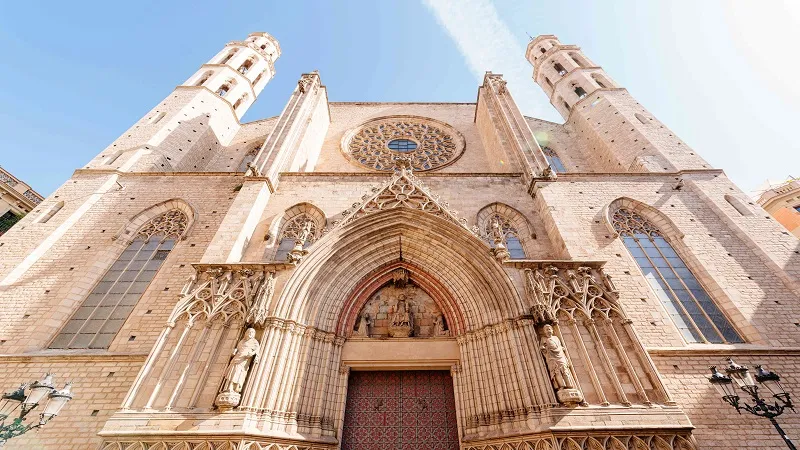
Monastery of Santa Maria de Montserrat
The Monastery of Santa María de Montserrat, often simply known as Montserrat, is a historic and important religious complex among Spanish churches, located on Montserrat Mountain near Barcelona, Catalonia, Spain. This unique and stunning monastery is famous for its beautiful surroundings, the veneration of the Black Madonna, and its cultural and spiritual significance. Let’s explore the history, architecture and cultural significance of Montserrat.
Unique features of the Monastery of Santa Maria de Montserrat
- Basilica: Montserrat Cathedral is a stunning example of Catalan Gothic architecture. It houses the revered statue of the Black Madonna, known as La Montera, which is a focal point of devotion for pilgrims.
- black madonna: Black Madonna is a statue with dark skin of Virgin Mary and baby Jesus. It is one of the most revered images in Catalonia and has attracted tourists for centuries.
- museum: Montserrat has an art museum with an impressive collection of works by famous artists, including El Greco, Caravaggio, and Picasso.
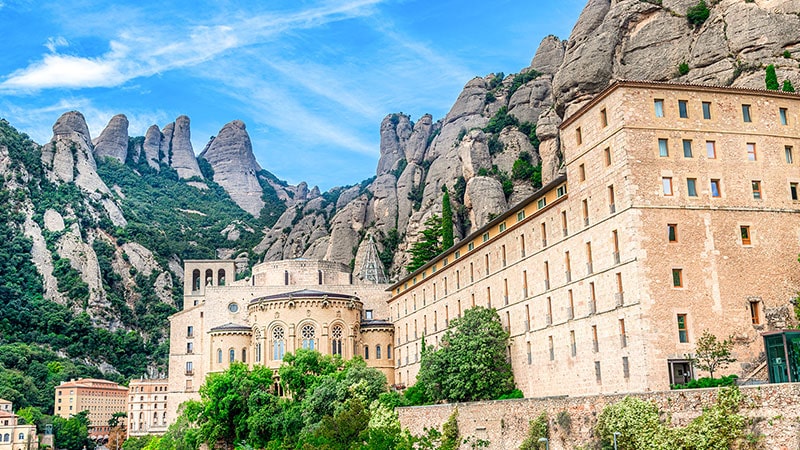
Santo Tomás Church is one of the best churches in Spain
The Church of Santo Tomas is an important religious building among Spanish churches located in the city of Valencia. With its rich history and baroque architecture, this church is important both as a place of worship and as a cultural heritage.
Unique features of Santo Tomas Church
- view: The exterior of the church has a baroque facade decorated with intricate and beautiful sculptures. The facade is a testimony to the artistic achievements of the Baroque period.
- Interior space: The interior of the church is equally impressive with a nave, baroque altars, paintings and sculptures adding to the church’s visual splendor.
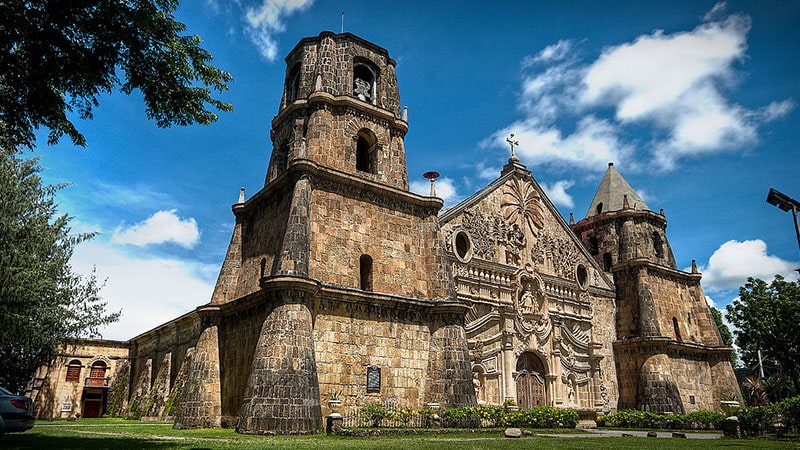
La Almudena Cathedral
La Almudena Church is a prominent Catholic church located in the city of Madrid, the capital of Spain. This church has significant cultural and religious importance among Spanish churches and is a remarkable architectural landmark in the heart of Madrid. Let’s explore the unique features of the Church of La Almodena.
Unique features of La Almodena church
- Modern construction: Unlike many historical European churches, this church is relatively new.
- Architectural styles: The Church of La Almodena is known for its eclectic architectural styles. Its design includes elements of neoclassical, neogothic, and neo-Romanesque architecture. The exterior and interior display a rich combination of these styles.
- view: The western facade of the church has a neoclassical design with sculptures and reliefs depicting various religious scenes and decorated with statues of saints and angels.
- the dome: One of the most recognizable features of this church is its huge dome that rises above the passage. The dome is covered with colorful ceramic tiles and topped with a cross.
- Interior space: The interior of La Almodena Church is beautiful with a nave decorated with neo-Gothic arches, columns and stained glass windows. The central altar is a focal point with its artwork and religious decorations.
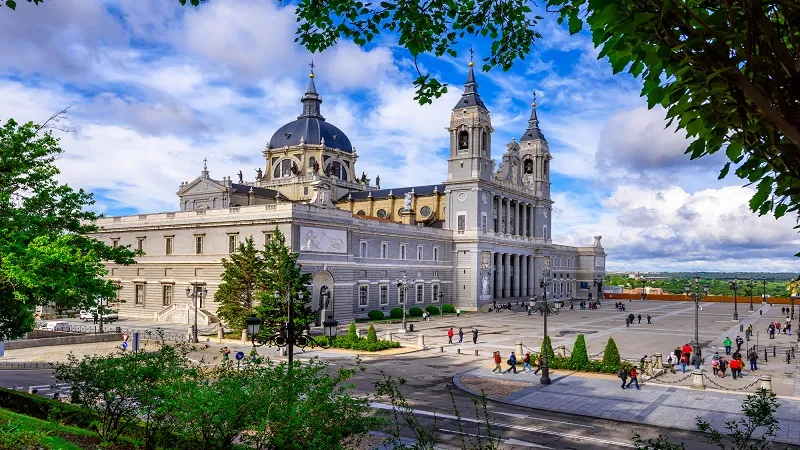
Mosque-Church of Cordoba (Mezquita of Cordoba).
The Mosque-Church of Córdoba is one of the most prominent and symbolic religious buildings in Spain, located in the historic city of Córdoba, in the Andalucía region of southern Spain. The Mosque-Church of Córdoba displays a fascinating blend of Islamic and Christian architecture that reflects Spain’s rich history of religious transition. Let’s look at the unique features of the Mezquita Church of Cordoba from the churches of Spain.
The unique features of the Mosque-Church of Cordoba
- Moorish architecture: The Mosque-Church of Córdoba is famous for its stunning Islamic architecture. The interior of the mosque has an enchanting forest of columns and horseshoe arches that creates a sense of spaciousness and peace. The famous double arches add to its unique visual appeal.
- the altar: Mihrab, the prayer niche that shows the direction of Mecca, is designed with very complex geometric patterns and calligraphy. It displays the artistic achievements of Islamic artisans.
- Christian elements: After becoming a church, Christian elements were integrated into the structure of this building. A renaissance-style nave and various churches were built, creating an attractive mix of Islamic and Christian architectural styles.
- bell tower: The bell tower was originally the minaret of the mosque. It offers a panoramic view of Córdoba and its surroundings.
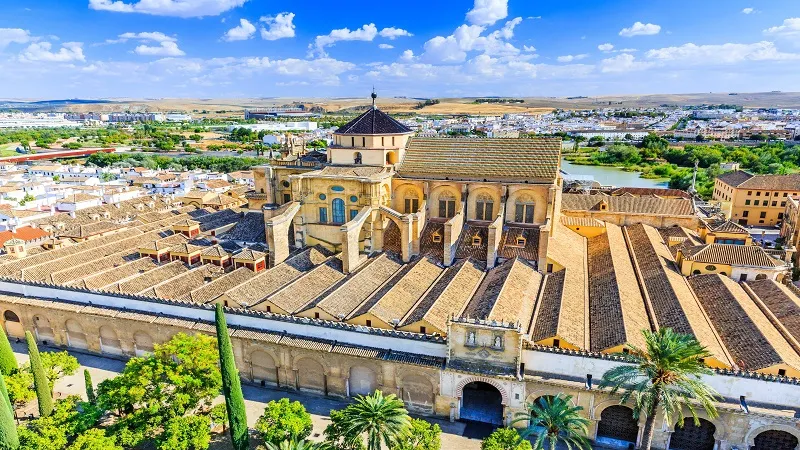
Read more: Introducing the city of Barcelona, Spain
Burgos Cathedral
Burgos Cathedral, officially known as the Church of Saint Mary of Burgos, is one of Spain’s most prominent churches and historically the most important religious building in Spain. Located in the city of Burgos, in the Castile and Leon region of northern Spain, this Gothic cathedral is admired for its stunning architecture, rich history, and artistic treasures. Let’s look at the architecture and cultural significance of Burgos Church.
Unique features of Burgos Church
- Gothic architecture: Burgos Church is an outstanding example of Spanish Gothic architecture. It has pointed arches, ribbed vaults, flying buttresses and intricate stonework, all of which contribute to its stunning visual appeal.
- facade and doors: The exterior is decorated with intricate sculptures, including scenes from the Bible and various religious figures. Each door has its own unique symbol and image.
- Churches and altars: The interior of the church has several prayer rooms, each of which has unique works of art and religious significance. The constable chapel, the Mozarabi chapel and the small chapel of the kings are among the most prominent of them.
- golden staircase: The Golden Staircase is a magnificent Renaissance staircase, a masterpiece of Spanish Renaissance architecture.
- Religious center: The Church of Burgos is still a place of worship and hosting religious ceremonies, which has made it an important spiritual center for the Catholic community in Spain.
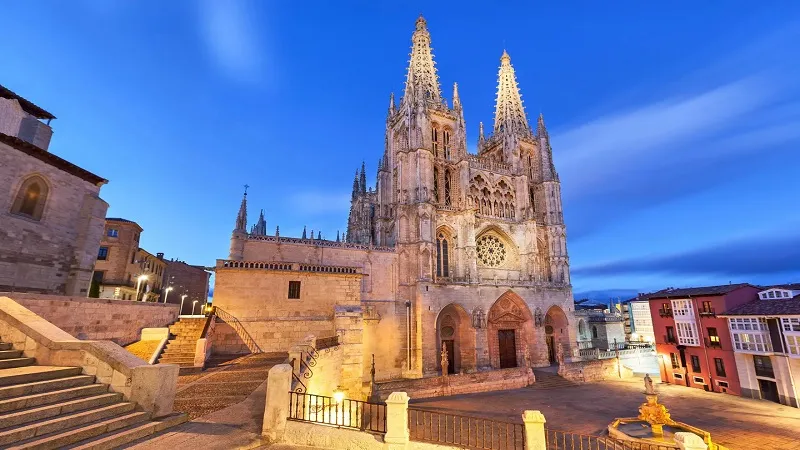
Basilica of Our Lady of the Pillar
The Church of Our Lady is a famous Roman Catholic church located in the city of Zaragoza, Spain. This church is one of the most important churches in Spain and one of the religious places in this country, and it has great cultural and historical importance, especially in the context of Catholicism in Spain. Let’s explore the history, architecture and cultural significance of the Church of Our Lady of the Pillar.
Unique characteristics of Our Lady
- Legendary origin: According to tradition, the history of the basilica is linked to the apparition of the Virgin Mary. The Virgin Mary is believed to have stood on a pillar during the apparition, hence the name of the basilica.
- Baroque style: The current church is predominantly in the Baroque architectural style, characterized by elaborate ornamentation, elaborate facades, and intricate interior details.
- Dome and towers: The basilica has a prominent dome and towers that dominate the skyline of Zaragoza. The dome is decorated with colorful ceramic tiles and has remarkable architectural features.
- Interior space: The interior of the basilica has lavish decorations, altars, sculptures and intricate frescoes. The main altar, dedicated to Our Lady of the Pillar, is a focal point of devotion and artistic beauty.
Read more: Other people’s experiences in traveling to Spain {tips for an ideal travel experience}
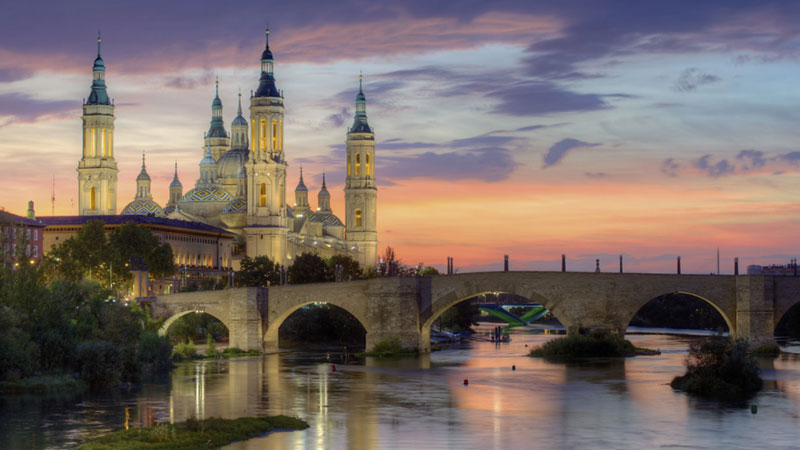
final word
Spain’s churches are not only places of worship but also cultural treasures that reflect the country’s complex history and diverse influences. From the majesty of the Sagrada Familia to the historic significance of the Mosque-Church of Córdoba, each of these churches invites visitors to discover a rich tapestry of Spain’s past and present. Whether you’re a history buff, an architecture buff, or a spiritual seeker, Spain’s churches offer a fascinating journey through time and faith.
If you are interested in visiting these churches, you can get guidance by booking a Spain tour and obtaining a Spanish tourist visa from Star Vank Airlines.
Copying of the contents of Setare Vanak Airline Agency is prohibited only by mentioning the source.
RCO NEWS













